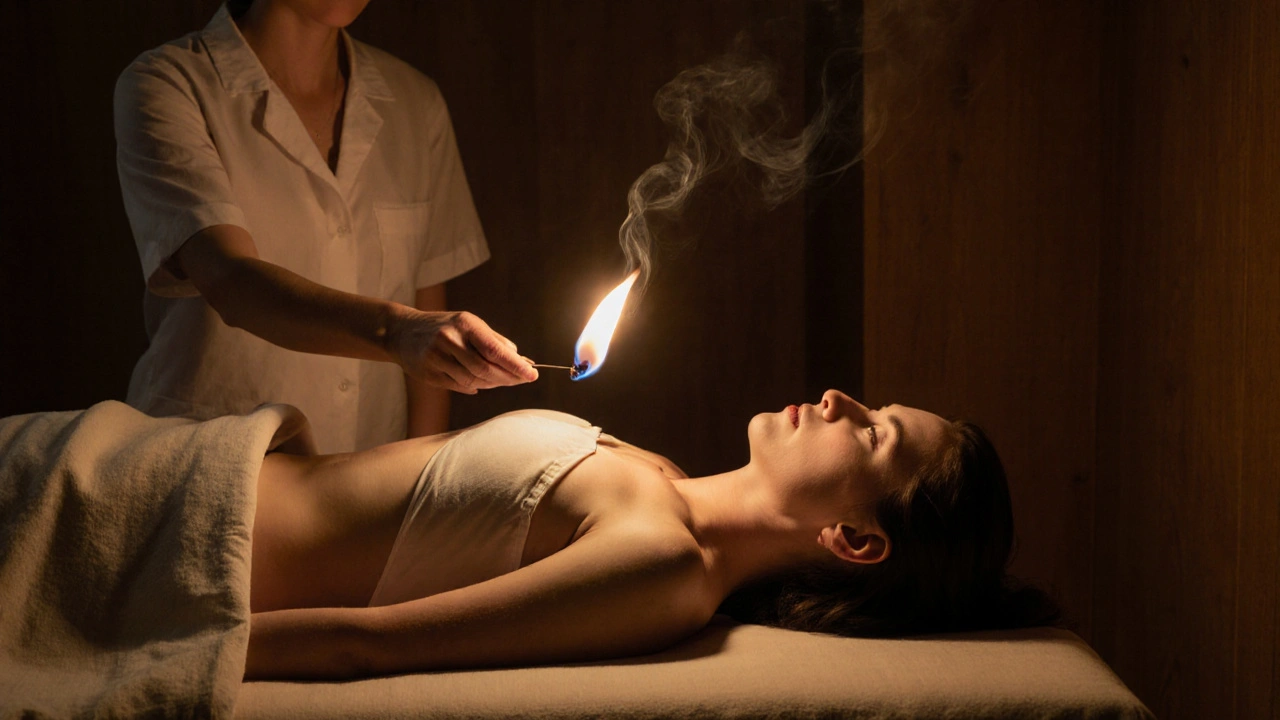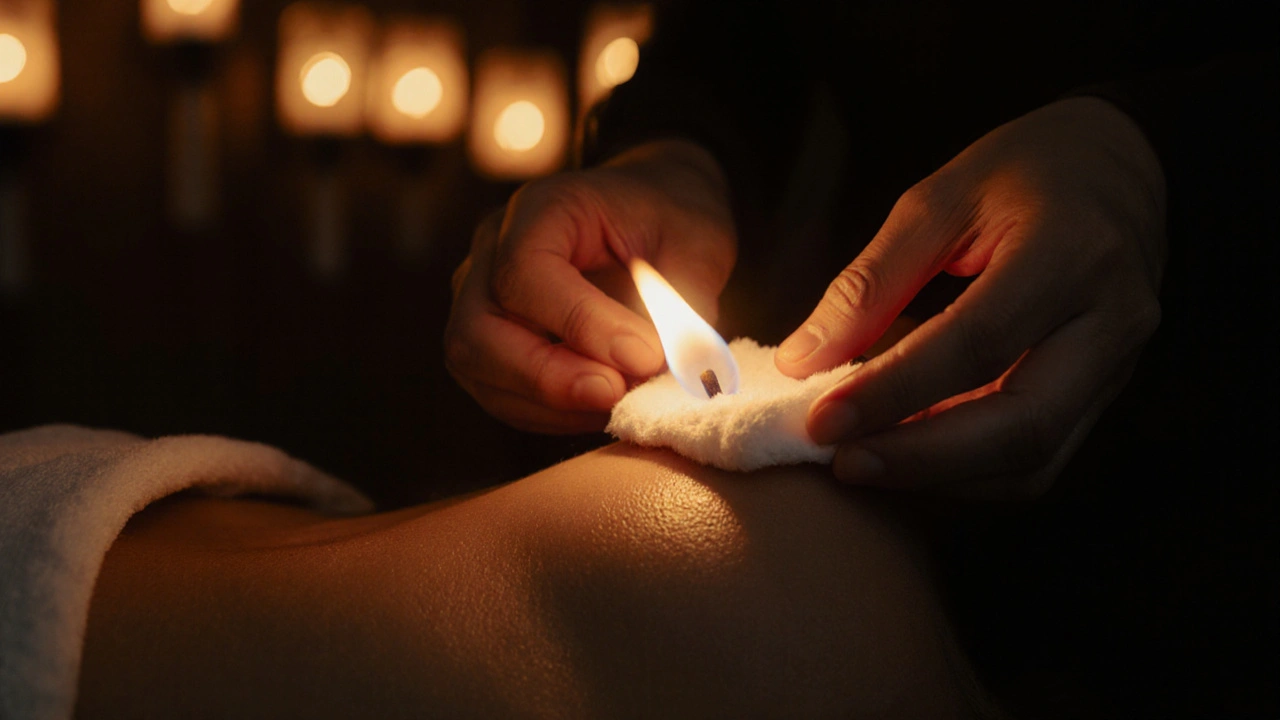Why Fire Massage is Rising in Popularity
 Nov, 15 2025
Nov, 15 2025
Fire Massage Suitability Checker
Check Your Fire Massage Suitability
Answer these questions to see if fire massage is safe and beneficial for you.
Picture this: you’re lying on a warm table, the room is dim, and a soft whooshing sound fills the air. Then, a gentle flame dances just above your skin-not burning, not scaring, but warming. That’s fire massage. It’s not new, but it’s suddenly everywhere: from wellness studios in Melbourne to boutique spas in Bali. People are lining up for it. And it’s not just a trend. There’s something real happening here.
What Exactly Is Fire Massage?
Fire massage, also called flame therapy or fire cupping with flame, uses controlled, brief bursts of flame to heat the skin and underlying tissues. Practitioners soak a cotton ball or pad in a safe, low-flashpoint oil-like grape seed or coconut oil-light it briefly, then quickly move it over the back, shoulders, or legs. The flame doesn’t touch the skin. It hovers just above, creating a wave of radiant heat that penetrates deep into muscles.
This isn’t fire as in danger. It’s fire as in energy. The heat relaxes fascia, boosts circulation, and triggers a parasympathetic response-your body’s natural ‘rest and digest’ mode. Unlike traditional hot stone massage, where heat is passive, fire massage delivers a dynamic, pulsing warmth that feels alive. Many clients describe it as a ‘deep sigh’ for their nervous system.
Why People Are Trying It Now
After years of pandemic stress, burnout, and digital overload, people are searching for therapies that do more than just relax muscles. They want to reset their entire system. Fire massage delivers that. It’s not just physical-it’s sensory. The crackle of flame, the scent of burning oil, the sudden warmth-it’s immersive. That’s why it’s catching on in cities like Melbourne, where wellness seekers are drawn to experiences that feel ancient yet deeply personal.
Unlike acupuncture or chiropractic care, fire massage doesn’t require you to talk about your trauma or explain your pain. You just lie down, breathe, and let the heat work. For people who feel overwhelmed by talk therapy or medical jargon, this is a relief. It’s therapy without words.
The Science Behind the Flame
There’s growing evidence that heat therapy improves circulation, reduces inflammation, and lowers cortisol levels. A 2023 study from the University of Sydney’s Integrative Medicine Lab found that participants who received fire massage sessions over six weeks showed a 22% average drop in resting cortisol levels and improved heart rate variability-a key marker of nervous system balance.
The heat from the flame causes vasodilation, meaning blood vessels widen. That increases oxygen and nutrient flow to tight muscles and damaged tissues. It also helps flush out metabolic waste like lactic acid. Think of it like a deep cleanse, but with fire instead of a sauna.
And while it sounds intense, the actual temperature at the skin’s surface rarely exceeds 45°C (113°F)-well below the threshold for burns. Skilled practitioners control duration, distance, and oil type to ensure safety. Most sessions last 15 to 25 minutes. No blisters. No scars. Just warmth.

Who Benefits Most?
Fire massage isn’t for everyone, but it’s especially powerful for certain groups:
- Chronic stress sufferers-the rhythmic heat calms the nervous system faster than meditation for many people.
- People with muscle stiffness-athletes, desk workers, and parents with tight shoulders report faster recovery.
- Those with poor circulation-the heat stimulates blood flow to extremities, helping cold hands and feet.
- People seeking non-pharmaceutical pain relief-many reduce reliance on NSAIDs after consistent sessions.
It’s also popular among women experiencing perimenopausal symptoms. The heat helps regulate body temperature spikes and eases tension in the lower back and hips, common trouble zones during hormonal shifts.
How It Compares to Other Heat Therapies
| Feature | Fire Massage | Hot Stone Massage | Infrared Sauna | Traditional Massage |
|---|---|---|---|---|
| Heat Type | Radiant, dynamic, moving | Conductive, static | Penetrating, ambient | None (unless combined) |
| Duration | 15-25 min | 60-90 min | 20-45 min | Varies |
| Depth of Penetration | Deep fascia and muscle | Superficial to mid-layer | Deep tissue | Manual pressure only |
| Nervous System Impact | Strong parasympathetic trigger | Moderate | Moderate | Depends on technique |
| Sensory Experience | High-sound, scent, sight | Low | Low | Low |
What sets fire massage apart isn’t just the heat-it’s the ritual. The flame isn’t just a tool; it’s part of the healing story. People remember the moment the flame passed over their skin. That memory sticks. And in a world of screens and noise, that kind of presence is rare.
What to Expect in Your First Session
If you’re curious, here’s what actually happens:
- You’ll lie face down on a heated table, fully clothed in loose, natural-fiber clothing (cotton or linen).
- The therapist will explain the process and check for contraindications-no open wounds, recent burns, or severe neuropathy.
- They’ll light a small pad soaked in oil and move it slowly along your back, neck, or legs, keeping it 1-3 cm away from your skin.
- You’ll feel a warm pulse, then a release. Some people feel tingling. Others feel nothing but deep relaxation.
- Afterward, you’ll be offered herbal tea and asked to rest for 10 minutes. No rushing. No phones.
Most people leave feeling lighter, calmer, and oddly centered. One client in Melbourne said, ‘It felt like my body finally remembered how to breathe.’

Who Should Avoid It?
Fire massage is safe for most people, but it’s not for everyone:
- People with severe diabetes or nerve damage (can’t feel heat properly)
- Those with pacemakers or implanted electronic devices (heat can interfere)
- Pregnant women (especially in the first trimester)
- Anyone with active skin infections or recent sunburn
- People with a history of burns or fear of fire (psychological discomfort outweighs benefits)
Always ask about the practitioner’s training. Reputable studios require certification in fire safety, anatomy, and controlled flame application. Don’t let someone with a YouTube tutorial light a flame near your skin.
Why It’s More Than a Trend
Fire massage isn’t rising in popularity because it’s Instagrammable. It’s rising because it works-on the body, on the mind, and on the spirit. In a time when people feel disconnected-from their bodies, from nature, from stillness-this therapy brings them back. The flame isn’t just heat. It’s a reminder: we are physical beings. We respond to warmth. We need ritual. We crave safety.
It’s ancient. It’s simple. And in a world of apps and algorithms, that’s revolutionary.
Is fire massage painful?
No, it’s not painful. The flame never touches the skin-it hovers just above. You’ll feel a sudden wave of warmth, like stepping into sunlight after being in the shade. Some people feel a slight tingle, but no burning or discomfort. If it ever feels too hot, you should speak up immediately-reputable practitioners will stop right away.
How often should I get fire massage?
Most people start with one session per month to assess how their body responds. If you’re dealing with chronic stress or muscle tension, weekly sessions for 4-6 weeks can create lasting change. After that, maintenance every 4-6 weeks is common. Listen to your body-some people feel the benefits for days, others need more frequent sessions.
Can I do fire massage at home?
Absolutely not. Fire massage requires professional training in flame control, oil selection, and safety protocols. Home attempts have led to burns and fires. Even experienced yoga or massage therapists don’t try this without certification. It’s not a DIY ritual-it’s a therapeutic technique.
Does fire massage help with cellulite or skin tone?
It’s not a cellulite treatment, but improved circulation can temporarily plump the skin and reduce puffiness. Some clients notice a glow after a few sessions, but that’s due to increased blood flow-not fat loss. Don’t expect dramatic skin changes-focus on the deeper benefits: relaxation, pain relief, and nervous system balance.
Where can I find a certified fire massage therapist?
Look for holistic wellness centers, integrative health clinics, or licensed massage therapists who specialize in energy or traditional Asian therapies. In Melbourne, studios like The Flame Room and Stillpoint Wellness offer certified fire massage. Always ask about their training-reputable therapists will show you their certification from recognized institutions like the Australian Institute of Integrative Medicine.
What’s Next?
If fire massage resonates with you, start small. Book one session. Don’t go in expecting magic-go in expecting stillness. Let the flame do its work. Afterward, notice how your body feels the next day. Are you sleeping better? Are your shoulders looser? Is your mind quieter?
That’s the real measure of its value. Not how many likes it gets online. But how quietly, deeply, it changes the way you live.
